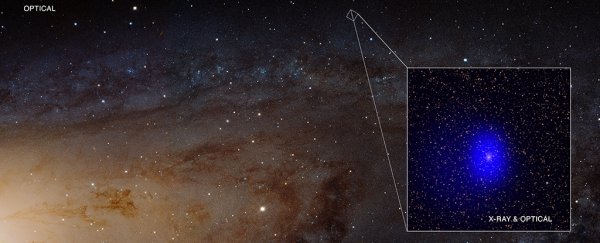A photo of our galactic neighbour Andromeda has revealed a surprise subject - an X-ray source initially thought to be inside Andromeda, but which turned out to be 1,000 times farther away.
Using data from NASA's Chandra X-ray observatory and from ground-based optical telescopes, astronomers have discovered a binary supermassive black hole that may be the most tightly paired ever discovered.
It's called J0045+41, and astronomers initially thought it was a star in the Andromeda galaxy, which at 2.5 million light years away is relatively close to us, and will probably merge with the Milky Way in about 4 billion years.
"We were looking for a special type of star in M31 and thought we had found one," said lead researcher Trevor Dorn-Wallenstein, a graduate student at the University of Washington in Seattle. "We were surprised and excited to find something far stranger!"
When it was thought to be inside Andromeda, researchers classified J0045+41 as a pair of stars that orbit each other once every 76 days. But data from Chandra showed that the intensity of the X-ray signal was too powerful to fit this classification.
Dorn-Wallenstein thought it may have been a binary black hole and neutron star - so he started studying it to find out.
But then spectral data from the Gemini-North telescope in Hawaii showed that J0045+41 had to contain at least one supermassive black hole - which then allowed the researchers to calculate the object's distance.
The powerful X-ray source turned out to be 2.6 billion light-years away - and the most likely cause is a pair of supermassive black holes wrapped in a tight binary orbit.
Combined, the two black holes have a total mass 200 million times that of the Sun. The black hole in the centre of our Milky Way galaxy, Sagittarius A*, has a mass around 4 million times the mass of the Sun.
And they're orbiting each other super close, too - a distance just a few hundred times the distance between the Earth and the Sun, less than one hundredth of a light-year.
The team believes that the two black holes could have each been at the centre of a galaxy, coming together when the two galaxies merged. They're slowly being pulled together by their gravity and will, at some point, collide.
Because they are unable to ascertain exactly how much mass is in each of the black holes, the researchers said, they can't give an accurate timeline for this collision. It could be anywhere between 350 years and 360,000 years.
Although the merger of the two black holes would be sending out gravitational waves, these wouldn't be detectable by our current gravitational wave detectors at LIGO and Virgo.
"Supermassive black hole mergers occur in slow motion compared to stellar-mass black holes," said Dorn-Wallenstein.
"The much slower changes in the gravitational waves from a system like J0045+41 can be best detected by a different type of gravitational wave facility called a Pulsar Timing Array."
The team's research has been published in The Astrophysical Journal, and can be read in full on arXiv.
